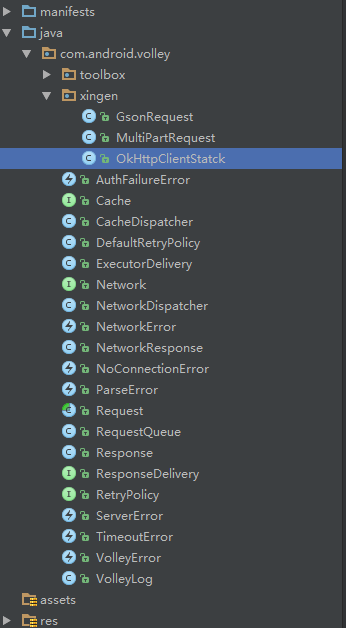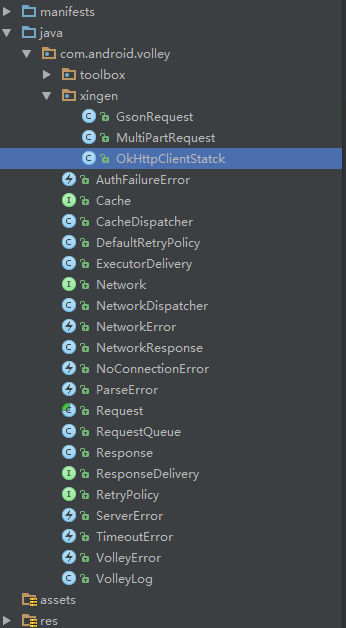本篇博客内容:
讲解volley部分源码
在框架源码中,添加OkHttp作为传输层
在框架源码中,添加Gson解析的 GsonRequest
在框架源码中,添加 文件上传的MultiPartRequest
在前面两篇博客,已经记录如何自定义项目需求的请求。这里来讲解如何修改Volley源码,自定义需求框架。
1.先来了解下Volley部分源码:
在Volley.java中,可以看到一些配置,例如联网操作类(HttpURLConnection或者androids-http-clients),磁盘缓存,线程池(实际上是4个网路线程,一个缓存线程)。
/**
* 用途:
* 初始化Volley中网络配置,异步线程配置,磁盘缓存配置
*/
public class Volley {
/** Default on-disk cache directory. 默认缓存的文件夹名*/
private static final String DEFAULT_CACHE_DIR = "volley";
/**
* Creates a default instance of the worker pool and calls {@link RequestQueue#start()} on it.
*
* @param context A {@link Context} to use for creating the cache dir.
* @param stack An {@link HttpStack} to use for the network, or null for default.
* @return A started {@link RequestQueue} instance.
*
* 创建一个默认的工作池对象,且调用RequestQueue的start()
* 参数Contentxt用于创建磁盘缓存的文件夹
* 参数HttpStack用于网络工作,默认是nulll
*/
public static RequestQueue newRequestQueue(Context context, HttpStack stack) {
//在手机内存中创建一个缓存数据的文件夹
File cacheDir = new File(context.getCacheDir(), DEFAULT_CACHE_DIR);
String userAgent = "volley/0";
try {
String packageName = context.getPackageName();
PackageInfo info = context.getPackageManager().getPackageInfo(packageName, 0);
userAgent = packageName + "/" + info.versionCode;
} catch (NameNotFoundException e) {
}
if (stack == null) {
//api版本不小于9,则使用java中HttpURLConnection作为联网方式
if (Build.VERSION.SDK_INT >= 9) {
stack = new HurlStack();
} else {
// Prior to Gingerbread, HttpUrlConnection was unreliable.
// See: http://android-developers.blogspot.com/2011/09/androids-http-clients.html
stack = new HttpClientStack(AndroidHttpClient.newInstance(userAgent));
}
}
//创建一个执行网络工作的操作类
Network network = new BasicNetwork(stack);
//创建一个请求队列,添加磁盘缓存的操作类,执行网络工作的操作类
RequestQueue queue = new RequestQueue(new DiskBasedCache(cacheDir), network);
//开启。
queue.start();
return queue;
}
/**
* Creates a default instance of the worker pool and calls {@link RequestQueue#start()} on it.
*
* @param context A {@link Context} to use for creating the cache dir.
* @return A started {@link RequestQueue} instance.
*
* 创建一个默认的工作池对象,且调用RequestQueue的start()
* 参数Contentxt用于创建磁盘缓存的文件夹
*
*/
public static RequestQueue newRequestQueue(Context context) {
return newRequestQueue(context, null);
}
}从上面源码可知,当当前手机系统的api>=9 时候,volley才有HttpURLConnection来连接服务器。磁盘缓存,线程池这里暂时省略不讲解。接下来了解下,HurlStack这类。
HurlStack这个类包括了这几个操作,设置请求的header和body,以及读取响应数据。
/**
* An {@link HttpStack} based on {@link HttpURLConnection}.
*
* 用途:
* 用HttpURLConnection作为联网通讯类。
*/
public class HurlStack implements HttpStack {
...................//部分源码未贴出
/**
* 执行HttpURLConnection,返回HttpResponse
*
* @param request the request to perform
* @param additionalHeaders additional headers to be sent together with
* {@link Request#getHeaders()}
* @return
* @throws IOException
* @throws AuthFailureError
*/
@Override
public HttpResponse performRequest(Request<?> request, Map<String, String> additionalHeaders)
throws IOException, AuthFailureError {
...................//部分源码未贴出
String url = request.getUrl();
//创建一个HttpUrlConnection或者其子类,进行网络连接。
URL parsedUrl = new URL(url);
HttpURLConnection connection = openConnection(parsedUrl, request);
//添加Http的标头
for (String headerName : map.keySet()) {
connection.addRequestProperty(headerName, map.get(headerName));
}
//根据volley中请求,来设置HttpUrlConnection的连接方式,和传递的内容
setConnectionParametersForRequest(connection, request);
...................//部分源码未贴出
}
/**
* Opens an {@link HttpURLConnection} with parameters.
* @param url
* @return an open connection
* @throws IOException
*
* 根据url中带有的协议,来开启一个带有参数的HttpURLConnection,或者HttpsURLConnection
*/
private HttpURLConnection openConnection(URL url, Request<?> request) throws IOException {
HttpURLConnection connection = createConnection(url);
int timeoutMs = request.getTimeoutMs();
//设置连接时间
connection.setConnectTimeout(timeoutMs);
//设置读取时间
connection.setReadTimeout(timeoutMs);
//不设置http缓存
connection.setUseCaches(false);
connection.setDoInput(true);
// use caller-provided custom SslSocketFactory, if any, for HTTPS
// 若是HTTPS协议,则使用HttpsURLConnection进行连接,且添加自定义的SSLSocketFactory
if ("https".equals(url.getProtocol()) && mSslSocketFactory != null) {
((HttpsURLConnection)connection).setSSLSocketFactory(mSslSocketFactory);
}
return connection;
}
/**
* Create an {@link HttpURLConnection} for the specified {@code url}.
* 通过URL开启一个客户端与url指向资源的间的网络通道。
*/
protected HttpURLConnection createConnection(URL url) throws IOException {
return (HttpURLConnection) url.openConnection();
}
/**
* 若是请求中存在Body(post传递的参数),则写入body到流中。
* @param connection
* @param request
* @throws IOException
* @throws AuthFailureError
*/
private static void addBodyIfExists(HttpURLConnection connection, Request<?> request)
throws IOException, AuthFailureError {
byte[] body = request.getBody();
if (body != null) {
//设置post请求方法,允许写入客户端传递的参数
connection.setDoOutput(true);
//设置标头的Content-Type属性
connection.addRequestProperty(HEADER_CONTENT_TYPE, request.getBodyContentType());
DataOutputStream out = new DataOutputStream(connection.getOutputStream());
//写入post传递的参数
out.write(body);
out.close();
}
}
}从上面源码可知:
1.创建HttpUrlConnection对象时通过createConnection(URL url)来实现的
2.添加请求的body会在addBodyIfExists()内调用request.getBody()来实现
3.添加请求的标头Content-type是调用request.getBodyContentType()来实现的。
了解联网操作类HttpUrlConnection如何创建,如何添加请求的Body和Header,便可以知道如何修改Volley源码。
2.使用OkHttp作为传输层:
OkHttp的描述:一个http+spdy的客户端,可以用于android 和java运用程序。
OkHttp的优势:
Http/2 支持允许全部(访问同一主机的)请求共享一个socket.
连接池减少请求延迟(若是Http/2不能使用)
3.数据压缩成GZIP格式,来缩小下载大小。
4.响应缓存可以避免重复(已经完成的网络操作的)请求
5.OkHttp perseveres,正当网络是麻烦:
它会默默地从常见连接问题池中恢复。
若是你的服务器有多个IP地址,当第一次连接失败,OkHttp会尝试使用备用地址。
这是必需的,对于IP4+IP6和(沉珂数据中的)主机服务- OkHttp初始化新连接是通过现今TLS功能(SNI,ALPN),若是握手失败,则回退到TLS1.0中
- 使用Okhttp是容易的,它的请求/响应的API是被设计成流畅builder和immutability.
它支持同步阻塞回调和异步回调。
OkHttp的版本变化:
OkHttp1.x 存在一些问题:
问题: OkHttp changes the global SSL context, breaks other HTTP clients
原因:OkHttp更改全局的SSL context,打断其他Http客户端
解决方式:创建自己的SSL context,不使用系统默认的。但是存在问题,自定义的SSLcontext会失去自定义的属性,这可能打破一些特征,例如证书固定。/** * 自定义一个SSLContext,而不使用默认的。 * * @return */ public static OkHttpClient createOkHttpClient(){ OkHttpClient okHttpClient=new OkHttpClient(); try { SSLContext sslContext = SSLContext.getInstance("TLS"); sslContext.init(null, null, null); okHttpClient.setSslSocketFactory( sslContext.getSocketFactory()); //避免OkHttp与UrlHttpConnection混合,出现某些方法找不到 //参考链接:https://github.com/square/okhttp/issues/673 URL.setURLStreamHandlerFactory(okHttpClient); ; } catch (GeneralSecurityException e) { throw new AssertionError(); // The system has no TLS. Just give up. } return okHttpClient; }获取HttpUrlConnection对象的方式:okHttpClient.open(url)
OkHttp2.x 存在一些问题:版本2.x修复以上的问题,但是仍然存在些问题:
问题:java.io.IOException: stream was reset: PROTOCOL_ERROR
原因:导致原因: OkHttp 发送标头使用的格式:accept-encoding: gzip 。 这导致nginx服务器报告一个protocol error
解决方式:http://mailman.nginx.org/pipermail/nginx/2015-October/048978.html// 强迫使用HTTP1.1: OkHttpClient client = new OkHttpClient(); // Disable HTTP/2 for interop with NGINX 1.9.5. client.setProtocols(Collections.singletonList(Protocol.HTTP_1_1));获取HttpUrlConnection对象的方式:OkUrlFactory(okHttpClient).open()
OkHttp3.x 版本已经比较成熟,实用起来也比较方便,通过构建者方式来创建对象。
更多关于OkHttp的信息,可以阅读 在github上的OkHttp项目连接:https://github.com/square/okhttp
原本打算都讲解下如何让OkHttp各个版本作为Volley的传输层,但是考虑到大多数人都是使用OkHttp3.x。故这里就不在讲解如何实现各个版本的OkHttp作为传输层。
先在Volley源码的Gradle中添加依赖库:
dependencies {
//OkHttp库
compile 'com.squareup.okhttp3:okhttp:3.5.0'
//okhttp-urlconnection库
compile 'com.squareup.okhttp3:okhttp-urlconnection:3.5.0'
//Gson库
compile 'com.google.code.gson:gson:2.2.4'
}然后,创建一个OkHttpClientStatck,来作为传输层(若是有需要的,可以在源码下自定义一个包,在包下创建)

思路:采用OkHttp作为传输层,替代原生的HttpUrlConnection。
实现方式:继承HurlStack 类,复写createConnection(URL url)返回OkHttpClient中的HttpURLConnection
OkHttpClientStatck.java完整代码如下:
/**
* Created by ${新根} on 2016/11/3.
* 博客:http://blog.csdn.net/hexingen
*
* 采用OkHttp作为传输层,替代原生的HttpUrlConnection
*/
public class OkHttpClientStatck extends HurlStack {
private OkHttpClient okHttpClient;
/**
* 采购构建者方式创建OkHttpClient
* OkHttpClient可以自定义拦截器,缓存,联网时间和写入时间等设置。
* Volley默认有这些东西,这里就不在设置。
*/
public OkHttpClientStatck(){
OkHttpClient.Builder builder=new OkHttpClient.Builder();
okHttpClient=builder.build();
}
/**
* 获取到OkHttpClient();
* @return
*/
private OkHttpClient getOkHttpClient(){
return okHttpClient;
}
/**
* 这里采用OkHttp框架中HttpURLConnection,而不使用原生的。
*
* OkHttpClient1.x:通过OkHttpClient.open(url)来获取
*
* OkHttpClient2.x:可以通过OkUrlFactory.open(URL url)来获取
*
* @param url
* @return
* @throws IOException
*/
@Override
protected HttpURLConnection createConnection(URL url) throws IOException {
String protocol= url.getProtocol();
if (protocol.equals("http")) return new OkHttpURLConnection(url, getOkHttpClient(),null);
if (protocol.equals("https")) return new OkHttpsURLConnection(url, getOkHttpClient(),null);
throw new IllegalArgumentException("Unexpected protocol: " + protocol);
}
}然后将OkHttpClientStatck添加到Volley中,作为默认的传输层:
在Volley.java中修改如下:
public class Volley {
............//部分源码未贴出
/**
* Creates a default instance of the worker pool and calls {@link RequestQueue#start()} on it.
*
* @param context A {@link Context} to use for creating the cache dir.
* @return A started {@link RequestQueue} instance.
*
* 创建一个默认的工作池对象,且调用RequestQueue的start()
* 参数Contentxt用于创建磁盘缓存的文件夹
*
*/
public static RequestQueue newRequestQueue(Context context) {
//修改源码:这里采用OkHttp作为传输层
return newRequestQueue(context, new OkHttpClientStatck());
}
}有人好奇为什么不用系统默认的HttpUrlConnetion,而用OkHttp作为传输层?
单纯的HttpUrlConnetion的使用起来存在一些问题,OkHttp不止针对其问题做了处理,还对连接服务器过程中一些问题做了处理。
Volley与OkHttp的整合已经完成了,整合后的Volley框架使用起来和原本的一样,自我鼓励下。
3.添加自定义的Request:
既然改了Volley的传输层,那再改Request也是顺手之劳。
在框架源码中,添加 GsonRequest,这里不再贴代码,感兴趣的可以阅读Gson解析的 GsonRequest
在框架源码中,添加 文件上传的MultiPartRequest ,这里有部分代码进行了修改,原本是上传文件的byte[],变成了上传file。省略了转化过程,使用起来更方便。
完整代码代码如下:
/**
* Created by 新根 on 2016/8/9.
* 用途:
* 各种数据上传到服务器的内容格式:
* <p/>
* 文件上传(内容格式):multipart/form-data
* String字符串传送(内容格式):application/x-www-form-urlencoded
* json传递(内容格式):application/json
*
* 博客:http://blog.csdn.net/hexingen
*/
public class MultiPartRequest<T> extends Request<T> {
private static final String TAG=MultiPartRequest.class.getSimpleName();
/**
* 解析后的实体类
*/
private final Class<T> clazz;
private final Response.Listener<T> listener;
/**
* 自定义header:
*/
private Map<String, String> headers;
private final Gson gson = new Gson();
/**
* 字符编码格式
*/
private static final String PROTOCOL_CHARSET = "utf-8";
private static final String BOUNDARY = "----------" + System.currentTimeMillis();
/**
* Content type for request.
*/
private static final String PROTOCOL_CONTENT_TYPE = "multipart/form-data; boundary=" + BOUNDARY;
/**
* 文件列表。参数1是文件名,参数2是文件
*/
private Map<String, File > fileList;
/**
* 多个文件间的间隔
*/
private static final String FILEINTERVAL = "\r\n";
public MultiPartRequest(int method, String url,
Class<T> clazz,
Response.Listener<T> listener, Response.ErrorListener errorListenerr) {
super(method, url, errorListenerr);
this.clazz = clazz;
this.listener = listener;
headers = new HashMap<>();
fileList = new HashMap<>();
}
@Override
protected Response<T> parseNetworkResponse(NetworkResponse response) {
try {
String json = new String(
response.data,
"utf-8");
T t = gson.fromJson(json, clazz);
return Response.success(t, HttpHeaderParser.parseCacheHeaders(response));
} catch (UnsupportedEncodingException e) {
return Response.error(new ParseError(e));
} catch (JsonSyntaxException e) {
return Response.error(new ParseError(e));
}
}
@Override
protected void deliverResponse(T t) {
listener.onResponse(t);
}
/**
* 重写getHeaders(),添加自定义的header
*
* @return
* @throws AuthFailureError
*/
@Override
public Map<String, String> getHeaders() throws AuthFailureError {
return headers;
}
/**
* 设置请求的标头
* @param key
* @param content
* @return
*/
public Map<String, String> setHeader(String key, String content) {
if (!TextUtils.isEmpty(key) && !TextUtils.isEmpty(content)) {
headers.put(key, content);
}
return headers;
}
/**
* 添加文件名和文件数据
*
* @param fileName
* @param file
*/
public void addFile(String fileName, File file) {
if (!TextUtils.isEmpty(fileName) && file != null) {
fileList.put(fileName, file);
}
}
/**
* 重写Content-Type:设置为json
*/
@Override
public String getBodyContentType() {
return PROTOCOL_CONTENT_TYPE;
}
/**
* post参数类型
*/
@Override
public String getPostBodyContentType() {
return getBodyContentType();
}
/**
* post参数
*/
@Override
public byte[] getPostBody() throws AuthFailureError {
return getBody();
}
/**
* 将string编码成byte
*
* @return
* @throws AuthFailureError
*/
@Override
public byte[] getBody() throws AuthFailureError {
byte[] body;
ByteArrayOutputStream outputStream = null;
try {
outputStream = new ByteArrayOutputStream();
Set<Map.Entry<String, File>> set = fileList.entrySet();
int i=1;
for (Map.Entry<String,File> entry : set) {
//添加文件的头部格式
writeByte(outputStream, getFileHead( entry.getKey()));
//添加文件数据
writeByte(outputStream,fileTranstateToByte(entry.getValue()));
//添加文件间的间隔
if (set.size() > 1&&i<set.size()) {
i++;
Log.i(TAG,"添加文件间隔");
writeByte(outputStream, FILEINTERVAL.getBytes(PROTOCOL_CHARSET));
}
}
writeByte(outputStream, getFileFoot());
outputStream.flush();
body = outputStream.toByteArray();
return body == null ? null : body;
} catch (Exception e) {
return null;
} finally {
try {
if (outputStream != null) {
outputStream.close();
}
} catch (Exception e) {
}
}
}
/**
* 将file转成byte[]数据
*/
public byte[] fileTranstateToByte(File file){
byte[] data=null;
FileInputStream fileInputStream=null;
ByteArrayOutputStream outputStream = null;
try {
fileInputStream=new FileInputStream(file);
byte[] buffer=new byte[1024];
int length=0;
while ((length=fileInputStream.read(buffer))!=-1){
outputStream.write(buffer,0,length);
}
outputStream.flush();
data= outputStream.toByteArray();
}catch (Exception e){
data=null;
e.printStackTrace();
}finally {
try {
if (outputStream != null) {
outputStream.close();
}
if(fileInputStream!=null){
fileInputStream.close();
}
} catch (Exception e) {
}
}
return data;
}
public void writeByte(ByteArrayOutputStream outputStream, byte[] bytes) {
if(bytes!=null){
outputStream.write(bytes, 0, bytes.length);
}
}
/**
* 获取到文件的head
*
* @return
*/
public byte[] getFileHead(String fileName) {
try {
StringBuffer buffer = new StringBuffer();
buffer.append("--");
buffer.append(BOUNDARY);
buffer.append("\r\n");
buffer.append("Content-Disposition: form-data;name=\"media\";filename=\"");
buffer.append(fileName);
buffer.append("\"\r\n");
buffer.append("Content-Type:application/octet-stream\r\n\r\n");
String s = buffer.toString();
return s.getBytes("utf-8");
} catch (Exception e) {
e.printStackTrace();
return null;
}
}
/**
* 获取文件的foot
*
* @return
*/
public byte[] getFileFoot() {
try {
StringBuffer buffer = new StringBuffer();
buffer.append("\r\n--");
buffer.append(BOUNDARY);
buffer.append("--\r\n");
String s = buffer.toString();
return s.getBytes("utf-8");
} catch (Exception e) {
return null;
}
}
}
最终项目结构如下:

总结:
1. Volley框架的设计是相当不错的,具备1个缓存线程,4个网络线程,可以避免相同的Url的请求并发访问服务器
2. Volley框架带有图片处理ImageLoader,防止在ImageView在listview,gridview,recycleview中错乱。
3. Volley也带有磁盘缓存,可以自行配置内存缓存。
4. OkHttp也是带有磁盘缓存(需配置),异步或者同步执行,请求重试,拦截器等等。
这篇 Volley+OkHttp+Gson结合使用,较为适合普通项目中需求。例如加上断点续传,下载大数据的文件(volley不具备的优势),还可以继续深入的修改结合使用。慢慢长征路,还需继续走下去。























 796
796

 被折叠的 条评论
为什么被折叠?
被折叠的 条评论
为什么被折叠?








